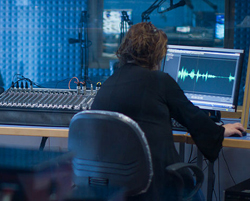
3. Relationships & Groove
The most important aspect of mixing is levels. That is the gig.
Getting the levels right is essential — more important than EQ, compression, reverb, and all of that.
But how do you know where to set them? Well, the rough mix already gave us a clue.
The next step is hearing how the elements relate.
What is really creating the movement in the record? Here are some examples.
Listen to almost any Red Hot Chili Peppers song and you’ll notice that the bass is pretty freakin loud, and the kick and snare are very forward. The bass and the backbeat are really driving the song, so that’s what sticks out.
Now let’s look at Green Day. Here the overheads and guitars are very loud because the drive is really coming from those elements.
Listen to any trap style hip-hop record and you’ll hear the 808 type bass and tight closed hi-hats way up.
Also consider how everything is connected. Turning up the buzz bass can make the sub bass seem louder. Turning the bass down can make the hi-hats come forward.
The conga rhythm may be working off the rhythm guitar. Placing them at similar levels and panned in the same place may make the track cohesive. Listen to the interaction, see how it feels to you, and make your level and pan decisions based on that feeling.
4. Preliminary Cleanup
Solo mode is a no-no when mixing. It’s the devil’s temptress. You can hear an individual element nicely in solo mode, it’s easier to work with. But it’s all lies. When you pop it back into the mix that element really changes. Solo mode is only allowed in one place: preliminary clean up.
As you’re bringing up levels in the first stage of a mix, you may notice some stuff that just doesn’t sound right at all. Clipping, explosive plosives (say that ten times fast), weird resonances. A quick clean up can make things easier down the road.
At the same time, do not delve deep into EQ, compression, or other effects. Only get rid of the nagging problems. It’s important to have a picture of the entire mix sitting together before making any serious processing decisions.
5. Save As
Once everything has a basic level, pan, and is cleaned up and organized: Save As. “Super Mixer Song (Start)” and then Save As again: “Super Mixer Song (mix 1)”.
This way if you screw up or go down a bad path in ‘(mix 1)’, you can just pop open ‘(Start)’ and start fresh.
Matthew Weiss engineers from his private facility in Philadelphia, PA. A list of clients and credits are available at Weiss-Sound.com.
Be sure to visit the Pro Audio Files for more great recording content. To comment or ask questions about this article go here.
